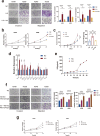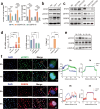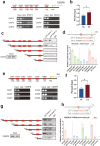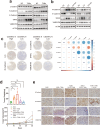IL6-STAT3-C/EBPβ-IL6 positive feedback loop in tumor-associated macrophages promotes the EMT and metastasis of lung adenocarcinoma
- PMID: 38424624
- PMCID: PMC10903044
- DOI: 10.1186/s13046-024-02989-x
IL6-STAT3-C/EBPβ-IL6 positive feedback loop in tumor-associated macrophages promotes the EMT and metastasis of lung adenocarcinoma
Abstract
Background: Lung cancer is one of the most common tumors in the world, and metastasis is one of the major causes of tumor-related death in lung cancer patients. Tumor-associated macrophages (TAMs) are a major component of the tumor microenvironment (TME) and are frequently associated with tumor metastasis in human cancers. However, the regulatory mechanisms of TAMs in lung cancer metastasis remain unclear.
Methods: Single-cell sequencing analysis of lung cancer and normal tissues from public databases and from 14 patients who underwent surgery at Zhongshan Hospital was performed. In vitro co-culture experiments were performed to evaluate the effects of TAMs on lung cancer migration and invasion. Changes in the expression of IL-6, STAT3, C/EBPΒ, and EMT pathway were verified using RT-qPCR, western blotting, and immunofluorescence. Dual luciferase reporter assays and ChIP were used to reveal potential regulatory sites on the transcription factor sets. In addition, the effects of TAMs on lung cancer progression and metastasis were confirmed by in vivo models.
Results: TAM infiltration is associated with tumor progression and poor prognosis. IL-6 secreted by TAMs can activate the JAK2/STAT3 pathway through autocrine secretion, and STAT3 acts as a transcription factor to activate the expression of C/EBPβ, which further promotes the transcription and expression of IL-6, forming positive feedback loops for IL6-STAT3-C/EBPβ-IL6 in TAMs. IL-6 secreted by TAMs promotes lung cancer progression and metastasis in vivo and in vitro by activating the EMT pathway, which can be attenuated by the use of JAK2/STAT3 pathway inhibitors or IL-6 monoclonal antibodies.
Conclusions: Our data suggest that TAMs promote IL-6 expression by forming an IL6-STAT3-C/EBPβ-IL6 positive feedback loop. Released IL-6 can induce the EMT pathway in lung cancer to enhance migration, invasion, and metastasis. The use of IL-6-neutralizing antibody can partially counteract the promotion of LUAD by TAMs. A novel mechanism of macrophage-promoted tumor progression was revealed, and the IL6-STAT3-C/EBPβ-IL6 signaling cascade may be a potential therapeutic target against lung cancer.
Keywords: Epithelial-mesenchymal transition; Interleukin-6; Lung adenocarcinoma; Metastasis; Tumor-associated macrophages.
© 2024. The Author(s).
Conflict of interest statement
The authors declare that they have no competing interests.
Figures







References
MeSH terms
Substances
LinkOut - more resources
Full Text Sources
Medical
Miscellaneous

